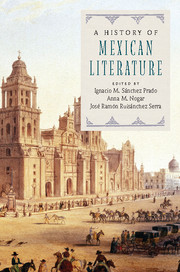Book contents
- Frontmatter
- Contents
- List of contributors
- Introduction
- PART I COLONIAL LITERATURE
- PART II THE NINETEENTH CENTURY
- PART III TWENTIETH AND TWENTY-FIRST CENTURIES
- 15 The Ateneo de la Juventud: The Foundations of Mexican Intellectual Culture
- 16 Regimes of the Avant-garde: Colonialists, Stridentists, Proletarians, Surrealists, Contemporáneos, and Independent Rupture (1920–1950)
- 17 The Institution of Fiction: From Yáñez, Rulfo, and Fuentes to Pitol and Del Paso
- 18 Octavio Paz: Literature, Modernity, Institutions
- 19 Mexican Poetry after the Avant-garde
- 20 Nonfictions: Essay, Criticism, and Chronicle
- 21 Balancing Acts: Twentieth- and Twenty-First-Century Mexican Theater
- 22 Women Writers in the Land of “Virile” Literature
- 23 The Hidden Histories of Gender: LGBTQ Writers and Subjectivities in Mexico
- 24 Mexican Literature in the Neoliberal Era
- PART IV MEXICAN LITERATURE BEYOND BOUNDARIES
- Index
- References
16 - Regimes of the Avant-garde: Colonialists, Stridentists, Proletarians, Surrealists, Contemporáneos, and Independent Rupture (1920–1950)
from PART III - TWENTIETH AND TWENTY-FIRST CENTURIES
Published online by Cambridge University Press: 05 July 2016
- Frontmatter
- Contents
- List of contributors
- Introduction
- PART I COLONIAL LITERATURE
- PART II THE NINETEENTH CENTURY
- PART III TWENTIETH AND TWENTY-FIRST CENTURIES
- 15 The Ateneo de la Juventud: The Foundations of Mexican Intellectual Culture
- 16 Regimes of the Avant-garde: Colonialists, Stridentists, Proletarians, Surrealists, Contemporáneos, and Independent Rupture (1920–1950)
- 17 The Institution of Fiction: From Yáñez, Rulfo, and Fuentes to Pitol and Del Paso
- 18 Octavio Paz: Literature, Modernity, Institutions
- 19 Mexican Poetry after the Avant-garde
- 20 Nonfictions: Essay, Criticism, and Chronicle
- 21 Balancing Acts: Twentieth- and Twenty-First-Century Mexican Theater
- 22 Women Writers in the Land of “Virile” Literature
- 23 The Hidden Histories of Gender: LGBTQ Writers and Subjectivities in Mexico
- 24 Mexican Literature in the Neoliberal Era
- PART IV MEXICAN LITERATURE BEYOND BOUNDARIES
- Index
- References
Summary
All categories include their own negation. Nowadays, to label and classify seems to be increasingly regarded as a long, tedious, and inefficient task. Subjects built on decades of research can easily be rejected by mere common sense. However, labels provide a great teaching tool: taxonomy – which helps at first to order what would otherwise appear as undecipherable chaos, too big and too heterogeneous to conceive as a single phenomenon.
What we should consider first is, what are the characteristics a vanguard movement needs in order to be defined as such? Rupture? Antagonism? Defiance? The Contemporáneos group, for example, always strove to break from classicism. Their goal was to become modern, not avant-garde, authors. At the opposite end of the avant-garde movement, colonialists should probably be called an arrière-garde. Although criticism artificially established these as divergent, disconnected groups, a more precise literary historiography reveals many overlaps between different authors and their gestures as they merged.
Do these labels matter? Contemporáneos (ap. Forster, Escalante, 1994), for instance, have not even used the generic group denomination themselves. Stridentists were not very far from them; magazines, collective books, and anthologies prove how both categories mix and separate, but also how their “members” were always in motion, so that no list is entirely sufficient. And dates? Surrealist literature in Mexico arrived late.
With full consciousness of the idle categories it proposes, this chapter introduces what could be regarded as different paths of aesthetic and political literary projects in Mexico between the 1920s and the 1950s, coinciding mostly with the historical vanguards.
Colonialism
It may be surprising to learn that between 1916 and 1926, while the Mexican Revolution was still being fought, the most successful novel model was not that of emerging civil war short stories, but rather on colonialist themes. Francisco Monterde – one of its representative authors, but also the critic that made the “Novel of the Revolution” a mainstream genre (by supporting the massive reprint of Mariano Azuela's Los de abajo in 1925 as a five-issue novel for the weekly publication of the cultural magazine El Universal Ilustrado) – remembers how both narrative styles coexisted. Before that, the revolutionary regime preferred to sponsor the printing of, and even give awards to, colonial pieces.
- Type
- Chapter
- Information
- A History of Mexican Literature , pp. 246 - 259Publisher: Cambridge University PressPrint publication year: 2016



